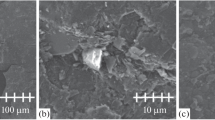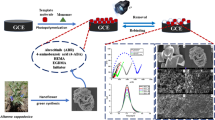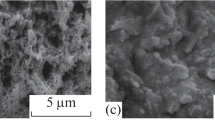Abstract
Developing electrochemical sensors for ascorbic acid, uric acid and glucose detection provides advantages of rapid, precise and economical monitoring of disease condition, and they have the potential to transform healthcare by enabling point-of-care diagnostic and personalised treatment. Facile and cost-effective potentiometric sensors have been developed in this work for selective and sensitive detection of ascorbic acid, uric acid and glucose, based on molecularly imprinted polymer (MIP). The imprinted polymeric matrix of para-aminobenzoic (pPABA) was developed on the surface of electrochemically reduced graphene oxide modified paraffin impregnated graphite rod electrode (rGO/PIGE). The monomeric para-aminobenzoic acid (PABA) was electropolymerised with template, viz., ascorbic acid, uric acid and glucose individually. The molecularly imprinted electrode surface was created by removing the trapped template molecule. The surface analysis of the modified electrodes was carried out by cyclic voltammetry (CV), scanning electron microscopy (SEM), attenuated total reflection spectroscopy (ATR), Raman spectroscopy and contact angle measurements. Parameters controlling the performance of the MIP (p-PABA), viz., pH of the supporting electrolyte and number of polymerisation cycle, were optimised. Under optimised conditions, the potentiometric responses of MIPs were linearly related to concentrations of ascorbic acid, uric acid and glucose in the range of 3.4 × 10−7 M–2.5 × 10−5 M, 3.3 × 10−7 M–1.3 × 10−5 M, and 3.5 × 10−7 M–2.9 × 10−5 M with a correlation coefficient, R2 of 0.99, 0.99 and 0.98 respectively. All three sensors showed high selectivity even in the presence of high concentration of similar interfering compounds. A limit of detection (LOD) for ascorbic acid, uric acid and glucose was found to be 1.1 × 10−8 M, 2.8 × 10−8 M and 1.3 × 10−8 M respectively. In addition, the developed sensors exhibited long-term stability and good reproducibility.


















Similar content being viewed by others
References
Arshady R, Mosbach K (1981) Synthesis of substrate-selective polymers by host-guest polymerization. Makromol Chem 182:687–692. https://doi.org/10.1002/macp.1981.021820240
Sellergren B (1997) Noncovalent molecular imprinting: antibody-like molecular recognition in polymeric network materials. Trends Anal Chem 16(6):310–320. https://doi.org/10.1016/S0165-9936(97)00027-7
Takeuchi T, Jun H (1999) Separation and sensing based on molecular recognition using molecularly imprinted polymers. J Chromatogr B Biomed Sci Appl 728(1):1–20. https://doi.org/10.1016/S0378-4347(99)00057-2
Wang H, Jiang J, Ma L (2006) Syntheses of molecularly imprinted polymers and their molecular recognition study for benzotriazole. React Funct Polym 66(10):1081–1086. https://doi.org/10.1016/j.reactfunctpolym.2006.01.022
Buszewski B, Ričanyová J, Gadzała-Kopciuch R, Szumski M (2010) Supramolecular recognition of estrogens via molecularly imprinted polymers. Anal Bioanal Chem 397:2977–2986. https://doi.org/10.1007/s00216-010-3859-5
Akgönüllü S, Kılıç S, Esen C, Denizli A (2023) Molecularly imprinted polymer-based sensors for protein detection. Polymers 15:629. https://doi.org/10.3390/polym15030629
Ramajayam K, Ganesan S, Ramesh P, Beena M, Kokulnathan T, Palaniappan A (2023) Molecularly imprinted polymer-based biomimetic systems for sensing environmental contaminants, biomarkers, and bioimaging applications. Biomimetics 8:245. https://doi.org/10.3390/biomimetics8020245
Mayes A, Whitcombe M (2005) Synthetic strategies for the generation of molecularly imprinted organic polymers. Adv Drug Deliv Rev 57(12):1742–1778. https://doi.org/10.1016/j.addr.2005.07.011
Shi Y et al (2006) Selective solid-phase extraction of cholesterol using molecularly imprinted polymers and its application in different biological samples. J Pharm Biomed Anal 42(5):549–555. https://doi.org/10.1016/j.jpba.2006.05.022
Lundie M, Željko S, Stanko T (2015) Electronic and optical properties of reduced graphene oxide. Journal of Materials Chemistry C 3(29):7632–7641. https://doi.org/10.1039/C5TC00437C
Tarcan R et al (2020) Reduced graphene oxide today. Journal of Materials Chemistry C 8(4):1198–1224. https://doi.org/10.1039/C9TC04916A
Zeng Y, Zhou Y, Zhou T, Shi G (2014) A novel composite of reduced graphene oxide and molecularly imprinted polymer for electrochemical sensing 4-nitrophenol. Electrochim Acta 130:504–511. https://doi.org/10.1016/j.electacta.2014.02.130
Zheng W et al (2018) Electrochemical sensor based on molecularly imprinted polymer/reduced graphene oxide composite for simultaneous determination of uric acid and tyrosine. J Electroanal Chem 813:75–82. https://doi.org/10.1016/j.jelechem.2018.02.022
Le T, Yukyung K, Hyeonseok Y (2017) Electrical and electrochemical properties of conducting polymers. Polymers 9(4):150. https://doi.org/10.3390/polym9040150
Nakamoto T, Mark M, Henry M (1984) The role of ascorbic acid deficiency in human gingivitis—a new hypothesis. J Theor Biol 108(2):163–171. https://doi.org/10.1016/S0022-5193(84)80063-6
El Ridi R, Hatem T (2017) Physiological functions and pathogenic potential of uric acid: a review. J Adv Res 8(5):487–493. https://doi.org/10.1016/j.jare.2017.03.003
Chen L et al (2019) Regulation of glucose and lipid metabolism in health and disease. Science China life sciences 62:1420–1458. https://doi.org/10.1007/s11427-019-1563-3
Zhang G et al (2016) Carbon nanohorns/poly (glycine) modified glassy carbon electrode: preparation, characterization and simultaneous electrochemical determination of uric acid, dopamine and ascorbic acid. J Electroanal Chem 760:24–31. https://doi.org/10.3390/s8117097
Yan J et al (2022) Measurement of serum uric acid by isotope dilution liquid chromatography tandem mass spectrometry: modification of a candidate reference measurement method and its clinical application. Int J Mass Spectrom 482:116911. https://doi.org/10.1016/j.ijms.2022.116911
Sato T et al (2008) Simultaneous determination of serum mannose and glucose concentrations in dog serum using high performance liquid chromatography. Res Vet Sci 84(1):26–29. https://doi.org/10.1016/j.rvsc.2007.03.002
Thompson C, Trenerry V (1995) A rapid method for the determination of total L-ascorbic acid in fruits and vegetables by micellar electrokinetic capillary chromatography. Food Chem 53(1):43–50. https://doi.org/10.1016/0308-8146(95)95784-4
Miyake M, Akimasa S, Terumichi N (1991) Simultaneous determination of creatinine and uric acid in human plasma and urine by micellar electrokinetic chromatography. J High Resolut Chromatogr 14(3):181–185. https://doi.org/10.1002/jhrc.1240140309
Frerichs V, Luis A (1998) Determination of glucose by capillary electrophoresis/laser-induced fluorescence in transdermally collected samples. Electrophoresis 19(15):2625–2629. https://doi.org/10.1002/elps.1150191510
Matos R et al (2000) Flow injection analysis-amperometric determination of ascorbic and uric acids in urine using arrays of gold microelectrodes modified by electrodeposition of palladium. Anal Chim Acta 404(1):151–157. https://doi.org/10.1016/S0003-2670(99)00674-1
Trojanowicz M, Matuszewski W, Podsiadła M (1990) Enzyme entrapped polypyrrole modified electrode for flow-injection determination of glucose. Biosens Bioelectron 5(2):149–156. https://doi.org/10.1016/0956-5663(90)80005-X
Scholz F, Birgit L (1992) Abrasive stripping voltammetry—an electrochemical solid state spectroscopy of wide applicability. Trends Anal Chem 11(10):359–367. https://doi.org/10.1016/0165-9936(92)80025-2
Liu Y et al (2011) Electrochemical sensor based on a poly (para-aminobenzoic acid) film modified glassy carbon electrode for the determination of melamine in milk. Electrochim Acta 56(12):4595–4602. https://doi.org/10.1016/j.electacta.2011.02.088
Ziyatdinova G et al (2022) Electropolymerized 4-aminobenzoic acid based voltammetric sensor for the simultaneous determination of food azo dyes. Polymers 14(24):5429. https://doi.org/10.3390/polym14245429
Yadav R et al (2011) Experimental IR and Raman spectra and quantum chemical studies of molecular structures, conformers and vibrational characteristics of L-ascorbic acid and its anion and cation. Spectrochim Acta Part A Mol Biomol Spectrosc 84(1):6–21. https://doi.org/10.1016/j.saa.2011.07.043
Kodati VR, Tu AT, Turumin J (1990) Raman spectroscopic identification of uric-acid-type kidney stone. Appl Spectrosc 44:1134–1136. https://doi.org/10.1366/0003702904086470
Mathlouthi M, Dang VL (1980) Laser-Raman spectra of d-glucose and sucrose in aqueous solution. Carbohyd Res 81(2):203–212. https://doi.org/10.1016/S0008-6215(00)85652-9
Nybacka L (2016) FTIR spectroscopy of glucose
Pradhane AP, Ravi NM, Shailesh GA (2022) Batch crystallization of uric acid: modeling, simulation, and the impact of 3, 7–dimethylxanthine. Cryst Res Technol 57(12):2200125. https://doi.org/10.1002/crat.202200125
Huhtamäki T et al (2018) Surface-wetting characterization using contact-angle measurements. Nat Protoc 13(7):1521–1538. https://doi.org/10.1038/s41596-018-0003-z
Buck RP, Lindner E (1994) Recommendations for nomenclature of ionselective electrodes (IUPAC Recommendations 1994). Pure Appl Chem 66(12):2527–2536. https://doi.org/10.1351/pac199466122527
Özcan L, Mutlu S, Yücel S (2008) Electrochemical preparation of a molecularly imprinted polypyrrole-modified pencil graphite electrode for determination of ascorbic acid sensors 8(9):5792–5805. https://doi.org/10.3390/s8095792
Wang Q et al (2021) Molecularly imprinted electrochemical sensor for ascorbic acid determination based on MXene modified electrode. Mater Lett 285:129158. https://doi.org/10.1016/j.matlet.2020.129158
Yan C et al (2016) A selective strategy for determination of ascorbic acid based on molecular imprinted copolymer of o-phenylenediamine and pyrrole. J Electroanal Chem 780:276–281. https://doi.org/10.1016/j.jelechem.2016.09.046
Tonelli D et al (2011) A novel potentiometric sensor for l-ascorbic acid based on molecularly imprinted polypyrrole. ElectrochimicaActa 56(20):7149–7154. https://doi.org/10.1016/j.electacta.2011.05.076
Diouf A, Benachir B, Nezha EB (2019) A nonenzymatic electrochemical glucose sensor based on molecularly imprinted polymer and its application in measuring saliva glucose. Mater Sci Eng, C 98:1196–1209. https://doi.org/10.1016/j.msec.2019.01.001
Çiftçi H, Tamer U (2012) Functional gold nanorod particles on conducting polymer poly(3-octylthiophene) as non-enzymatic glucose sensor. React Funct Polym 72(2):127–132. https://doi.org/10.1016/j.reactfunctpolym.2011.11.006
Alexander S et al (2017) "Highly sensitive and selective non enzymatic electrochemical glucose sensors based on graphene oxide-molecular imprinted polymer. Mater Sci Eng, C 78:124–129. https://doi.org/10.1016/j.msec.2017.04.045
Zheng W et al (2018) A molecularly-imprinted-electrochemical-sensor modified with nano-carbon-dots with high sensitivity and selectivity for rapid determination of glucose. Anal Biochem 555:42–49. https://doi.org/10.1016/j.ab.2018.06.004
Chen P et al (2010) Detection of uric acid based on multi-walled carbon nanotubes polymerized with a layer of molecularly imprinted PMAA. Sens Actuators, B Chem 146(2):466–471. https://doi.org/10.1016/j.snb.2009.11.035
Motghare RV et al (2015) Voltammetric determination of uric acid based on molecularly imprinted polymer modified carbon paste electrode. Electroanalysis 27(3):825–832. https://doi.org/10.1002/elan.201400579
Chen PY et al (2010) A novel molecularly imprinted polymer thin film as biosensor for uric acid. Talanta 80(3):1145–1151. https://doi.org/10.1016/j.talanta.2009.08.041
Wang Y et al (2019) Molecularly imprinted polydopamine modified with nickel nanoparticles wrapped with carbon: fabrication, characterization and electrochemical detection of uric acid. Microchim Acta 186:1–9. https://doi.org/10.1007/s00604-019-3521-7
Mir MA et al (2020) Nanoporous anodic alumina (NAA) prepared in different electrolytes with different pore sizes for humidity sensing. J Solid State Electrochem 24:1679–1686. https://doi.org/10.1007/s10008-020-04683-2
Wei et al (2023) Microwave-exfoliated 2D oligo-layer MoO3-x nanosheets with outstanding molecular adsorptivity and room-temperature gas sensitivity on ppb level. Chem Eng J 454:140076. https://doi.org/10.1016/j.cej.2022.140076
Hu Y et al (2020) Controllable growth and flexible optoelectronic devices of regularly-assembled Bi2S3 semiconductor nanowire bifurcated junctions and crosslinked networks. Nano Res 2226–2232. https://doi.org/10.1007/s12274-020-2841-6
Johan B (2020) Electrochemical sensors for real-world applications. J Solid State Electrochem 24(9):2039–2040. https://doi.org/10.1007/s10008-020-04700-4
Funding
This work is supported by the University Research Fellowship, Department of Analytical Chemistry, University of Madras.
Author information
Authors and Affiliations
Contributions
GB: conceptualization, methodology, investigation, visualisation, writing manuscript and review. DPN: supervision, visualisation, writing—review.
Corresponding author
Ethics declarations
Conflict of interest
The authors declare no competing interests.
Additional information
Publisher's Note
Springer Nature remains neutral with regard to jurisdictional claims in published maps and institutional affiliations.
Rights and permissions
Springer Nature or its licensor (e.g. a society or other partner) holds exclusive rights to this article under a publishing agreement with the author(s) or other rightsholder(s); author self-archiving of the accepted manuscript version of this article is solely governed by the terms of such publishing agreement and applicable law.
About this article
Cite this article
B, G., Deepa, P.N. Nanoarchitectonics of a new rGO/poly(p-aminobenzoic acid) (pPABA)-based molecularly imprinted polymer electrode for detecting ascorbic acid, uric acid and glucose. J Solid State Electrochem 28, 357–375 (2024). https://doi.org/10.1007/s10008-023-05767-5
Received:
Revised:
Accepted:
Published:
Issue Date:
DOI: https://doi.org/10.1007/s10008-023-05767-5




